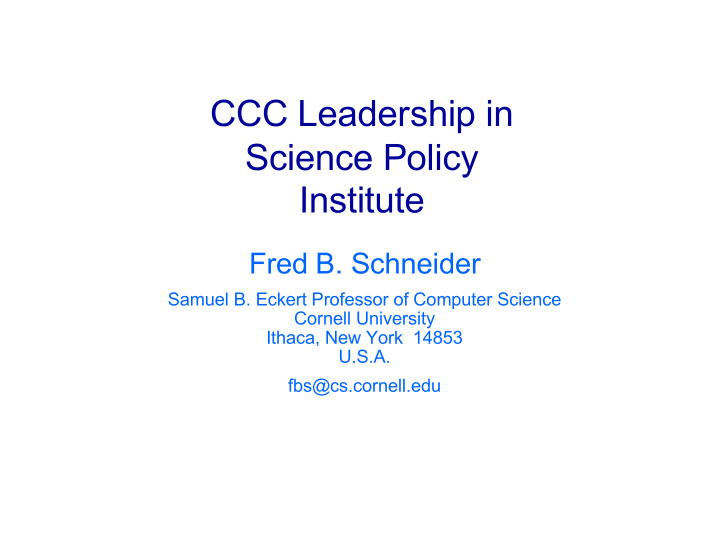



CCC Leadership in Science Policy Institute Fred B. Schneider Samuel B. Eckert Professor of Computer Science Cornell University Ithaca, New York 14853 U.S.A. fbs@cs.cornell.edu
Goals LISPI is a crash course in: – Relevant science policy issues – Mechanics of policy making § How is federal science policy crafted? § How is it implemented? § How can you be effective? – Opportunities to participate in policy-making process. Nb: Federal funds cannot be used to lobby at the federal, state, or local levels. LISPI is funded by federal funds. Any “ advocacy ” you see at LISPI is purely for purposes of illustration. Difference between “ education ” and “ lobbying ” ? 1
CRA and CCC Interfaces to DC 20 Indtrl Rsch Labs 200 PhD CS Depts 6 Prof Societies CRA Board of Directors CRA Gov affairs $$$ NSF CCC Council 2
Who Else Talks to DC? – Individuals – Professional societies § NAE, ACM, IEEE, …. – Business (including “ Higher Education ” ) – Consortia ( “ lobbyists ” ) – Think Tanks 3
Why Get Involved? ● Altruism – ” Ask not what your country can do for you - ask what you can do for your country ” ● Obligation – In US, higher-ed is a public trust. ● Pragmatism – Change the environment so you can better do “ your thing ” (e.g., research, teaching, …). 4
Ways to Connect ● Advise Research Funding Agencies – Influence direction (e.g. new initiatives) – Influence operation ● Advise Other Federal Agencies – Influence what/how they operate through: § Federal Advisory Cmte Act (=FACA) advisory committees § National Research Council (=NRC) boards and studies ● Advise Congress – Advice on legislation 5
Being Effective in DC A rather different culture and tactics from a university setting… – Don ’ t seek to get credit. (You probably won ’ t.) – Compromise is typically how you win. § Understand what others are seeking and why. – Organizations / Individuals optimize for: § More budget ( “ Follow the money . ” ) § More power (or less accountability / co-dependence) § More access – Re-election requires votes. § “ All politics are local. ” 6
Being Effective in DC Acknowledgement: Thomas Kalil. Policy Entrepreneurship at the White House Getting Things Done in Large Organizations. Innovations Vol 11 No 3 / 4. ● Show up (and be willing to do so whenever) ● Listen. Be prepared to summarize your opponents view as well as your opponent. ● Be succinct. Figure out the “end”. Give the “ask”. Then give a rationale that will compel this listener. ● Make it easy to give you help. ● Identify allies and recruit them. 7
A Cynic’s view of DC Strategy Winning characteristics for initiatives : – Different trumps more – New trumps improved – Reactive trumps proactive – Inclusive trumps exclusive § 50 states, a budget crisis (=competing interests), … 8
Schedule: Day 1 0830-0900: Overview 0900-1000: The Federal Case for Computing ----- 1015-1130: The Federal Budget Process 1130-1300: Advisory Committees and How to Serve on One 1300-1400: Lunch 1400-1500: Providing Testimony ------ 1530-1630: Having “ The Conversation ” (I) ------ 1645-1745: Expert Panel – Communicating Importance of the Field 1745- … : Reception 9
Schedule: Day 2 0800-0930: Interacting with Agencies/Creating New Initiatives 0930-1100: Embedding Researchers into Non-Research Agencies and the White House ----- 1115-1300: Having “ The Conversation ” (II) 1300: Wrap-up 10
Part II: Congressional Testimony 11
Congressional Testimony Committee on Science and Technology, Research and Science ● Education Subcommittee, hearing June 10, 2009 on Cybersecurity R&D. (Schneider) Committee on Science and Technology, Technology and Innovation ● Subcommittee, hearing October 22, 2009 on Cybersecurity Activities at NIST’s Information Technology Laboratory. (Schneider) Armed Services Committee, Terrorism, Unconventional Threats, and ● CapabilitiesSubcommitee, hearing Februrary 25, 2010 on Private Sector Perspectives on Department of Defense Information Technology and Cybersecurity Activities. (Schneider) Committee on Science and Technology, Research and Technology ● Subcommittee, hearing on Oct 28, 2015 on A review of the Networking and Information Technology Research and Development Program. (Hager) 12
A Congressional Hearing Mechanics of being a witness… – Discussion with Cmte Staff § Invitation only after they have heard your views § You pay for travel etc. – Submit written statement § CRA and other orgs can help you with polishing and details – Deliver 5 min oral statement § Likely different from your written statement – Q+A with Cmte (5 min / member) – Respond to post-hearing written questions. 13
The Big Day: Presentation Acknowldegment: Gene Spafford, Purdue Univ. http://spaf.cerias.purdue.edu/usgov/testimony.html ● Read bio and testimony of other panelists ● Practice (reading) your 5 min speech. And again. And again. And again. … With a stop watch. ● 5 minutes is a hard deadline. 14
The Big Day: Logistics Acknowldegment: Gene Spafford, Purdue Univ. http://spaf.cerias.purdue.edu/usgov/testimony.html ● Read the Washington Post that morning ● Dress appropriately ● Visit the rest room. ● Members will come and go. Ignore it. 15
The Big Day: The Question Period Acknowldegment: Gene Spafford, Purdue Univ. http://spaf.cerias.purdue.edu/usgov/testimony.html Question period: 5 minutes per member – Short answers help to cover more ground § Good responders ulitmately get more air time. § Don ’ t interrupt. But happily embrace interruptions. – You can ’ t explain the nuances, so don ’ t try. – You are not obligated to answer. Or you can promise data / details in a written follow-up – Questions are often written by staff. Make the best of the question. ( “ The premise makes no sense… ” is the wrong answer.) – This is not a debate. Do not direct comments to other witneseses and do not respond to the points they have made. 16
Recommend
More recommend